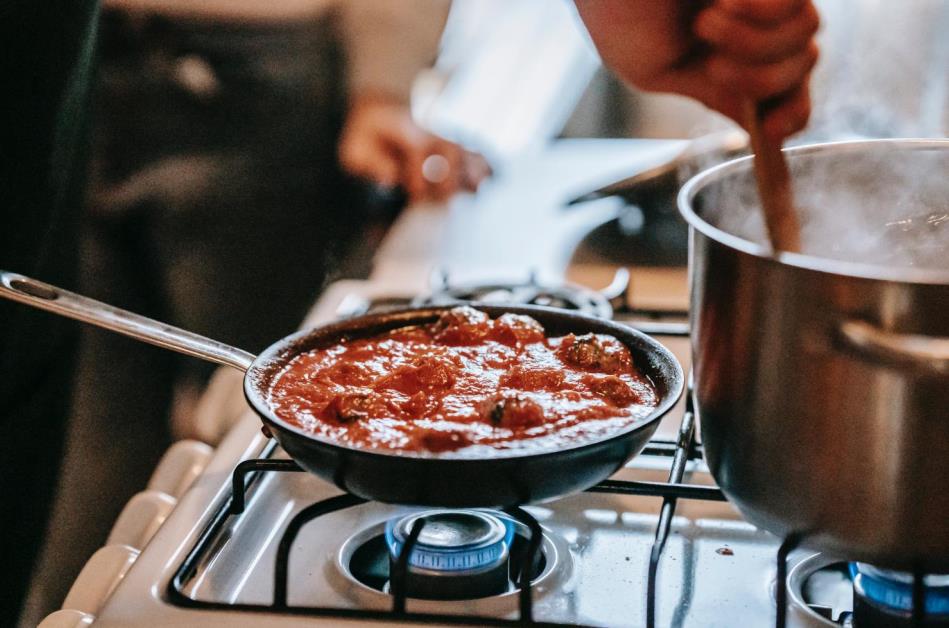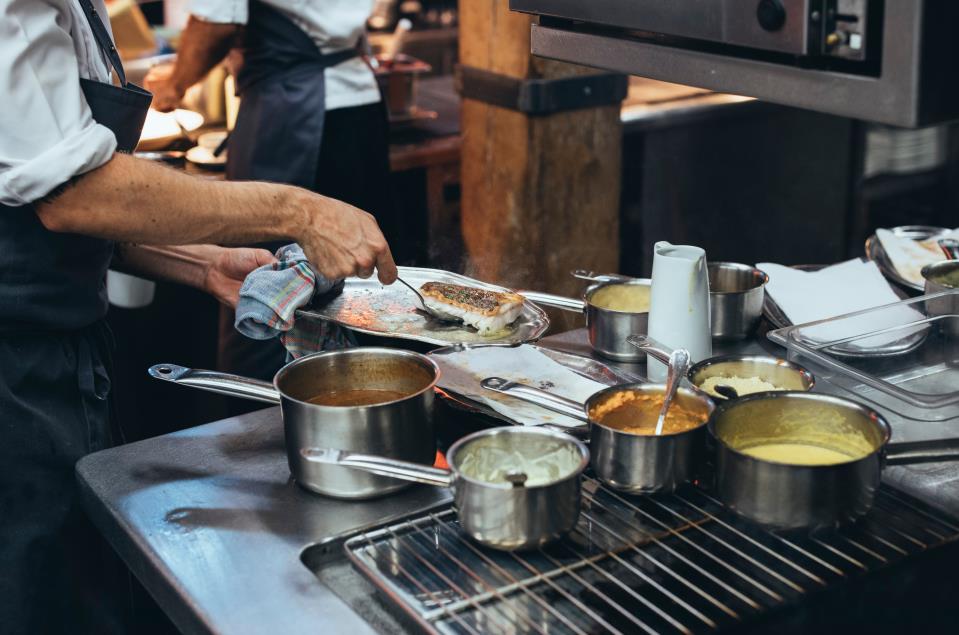The global cookware market will rise to $41.6 billion by 2032. With such a significant increase in market demand, selling high-quality cookware like non-stick or stainless steel can be an excellent option for businesses looking to expand their portfolio.
In this guide, we will go into the details of non-stick vs. stainless steel cookware, focusing on the benefits of each as a business opportunity.
So, let’s get going!
What is non-stick cookware made of?
When choosing the best non-stick pan material, the first thing to learn is what non-stick cookware is made of.
Non-stick cookware typically consists of a base material, like aluminum, with a non-stick coating.
This coating is designed to make cooking labor-saving and more convenient. As food slides easily off the surface, it saves time and energy. The nonstick coating is made of a synthetic material called polytetrafluoroethylene (PTFE), also known as Teflon.
PTFE is PFOA-free, which means that it does not contain perfluorooctanoic acid. PFOA is a chemical that is generally linked to health problems.
What is stainless steel cookware made of?
Stainless steel cookware is made of bars of stainless steel, the high chromium content in stainless steel makes the pots and pans resist corrosion and last longer.
Stainless steel is also non-reactive, unlike non-stick cookware. You can cook acidic and alkaline foods like sauces and meat without damaging the cookware.
Its durability, versatility, and ease of cleaning make it popular among cooks. Thus, increasing its demand and providing a lucrative business opportunity.
Non-stick vs. stainless steel: A product comparison
When it comes down to these two, both cookware has their own pros and cons. The non-stick cookware doesn’t let food stick to the base and is labor-saving to clean. On the other hand, stainless-steel cookware is durable, offers exceptional heat conduction, and is versatile.
Let’s look at what these two options offer in terms of product features in detail.
Buy Wholesale Cookware and Start Scaling up with Us Today
Contact us and connect with a sales rep to get a free quote.
Cooktops compatibility

Stainless steel cookware provides the convenience of being compatible with all types of cooktops. Be it an induction top or an electric stove, it works great with all. This allows you to prepare your favorite meals effortlessly without the worry of causing damage to the cookware.
In contrast, non-stick cookware has limitations when it comes to compatibility with induction stoves. This can make it less versatile in the kitchen and limit your options for cooking on certain types of cooktops.
Versatility
Stainless steel cookware can be used for anything from sautéing, searing, and browning in the oven. On the other hand, non-stick cookware is ideal for cooking at low to medium heat only.
Stainless steel cookware is also ideal for dishes that require high temperatures. Its durability and heat resistance suit various cooking techniques.
Health and safety
Initially, non-stick pans were manufactured with harmful chemicals that posed health risks for individuals. Although experts later developed PFOA-free cookware, there still remains uncertainty about its safety.
In contrast, stainless steel cookware makes a safe option for cooking and consuming prepared meals. Its composition ensures that there are no harmful substances that could potentially leach into your food.
Durability
The durability of stainless steel cookware is its significant selling point. Unlike non-stick cookware, which can wear out in 5-7 years, stainless steel pots and pans can withstand heavy use. This, too, without losing their non-reactive and non-stick properties.
Stainless steel is also a more sustainable choice for consumers. They don’t need to replace the non-stick pans every few years because they are durable. This can save your customers money in the long run.
This is especially important for businesses looking to sell cookware, as customers are increasingly interested in purchasing products built to last and have a minimal environmental impact.
Heat conduction and retention
Stainless steel can retain and distribute heat evenly across the cooking surface. This results in efficient and even cooking. It also maintains its temperature even when adding cold ingredients.

Non-stick cookware does allow for even cooking of the food. But since the material is thin and less conductive, it tends to cool down quickly.
Ease of cleaning
Stainless steel cookware can be cleaned with soap and water. But to remove burnt food or tough stains, you need to scrub them off forcefully. Since stainless steel cookware is dishwasher safe, you can let the machine do the work after removing the food residue.
Non-stick cookware, on the other hand, is easier to clean as food doesn’t stick to its surface. You don’t need excessive force to scrub it off. Non-stick cookware is generally not dishwasher safe. They should be hand-washed to prevent damage to the non-stick coating.
Maintenance
When it comes to maintenance, non-stick cookware is generally easier to care for than stainless steel cookware. Non-stick pans typically only require a simple wash with soap and water.
Cleaning stainless steel cookware after each use is recommended to prevent food stick and maintain its appearance. You can wash stainless steel pans with warm water and mild detergent. Avoid using abrasive cleaning tools that can scratch the surface.
Non-stick or stainless steel: the right cookware choice for your business?
From a business perspective, both stainless steel and non-stick cookware can be profitable. Ultimately, a cookware business’s success will depend on various factors. This includes product quality, pricing, and the target market.
Price
Stainless steel cookware is typically priced higher than non-stick cookware. This is due to the manufacturing cost and the quality of the raw material. Stainless steel is a durable and long-lasting material. And so it requires more expensive manufacturing processes such as welding and polishing.
Non-stick cookware is generally less costly as the non-stick coating is applied to a base material only, such as aluminum. However, the quality and durability of non-stick coatings can vary widely depending on the type and thickness of the coating.
Target market

Stainless steel cookware appeals to a more upscale market that values quality, longevity, and versatility. This may include consumers such as professional chefs willing to pay a premium for cookware.
Non-stick cookware may appeal to a wider range of consumers looking for budget-friendly, easy-to-use cookware. This may include busy families, college students, and novice cooks who prioritize convenience and ease of use.
Also, it may be ideal for health-conscious consumers looking for ways to cook in minimum oil or butter.
Durability
Stainless steel cookware is durable and does not need frequent replacements, reducing business costs. Customers are also less likely to complain about the cookware breaking or needing to be replaced often. This can lead to greater customer satisfaction and loyalty.
In contrast, non-stick cookware requires frequent replacements. This is due to its limited durability, which can result in additional costs and lower customer satisfaction.
Should you sell non-stick or stainless steel cookware?
The global non-stick cookware industry is expected to grow to $31.4 billion by 2031. In comparison, the global market for stainless steel is expected to rise at CAGR of 6.5% by 2031.
Buy Wholesale Cookware and Start Scaling up with Us Today
Contact us and connect with a sales rep to get a free quote.
While selling both types of cookware seems lucrative, it is important to weigh a few factors, such as:
- Customer base
- price point
- food your customers are cooking, and
- long-term business profitability.
Let’s discuss these in some detail.
First, you should consider your customer base. Are they health-conscious and looking for cookware requiring less oil and butter?
If so, non-stick cookware may be the better option for your business. On the other hand, stainless steel may be the better choice if your customers are serious home cooks or professional chefs who value durability and longevity.
Second, you should think about the price point. Non-stick cookware tends to be less expensive than stainless steel, making it a more accessible option for customers on a budget.
However, it’s important to note that non-stick cookware needs to be replaced more frequently, which may turn some customers off.
Stainless steel, while more expensive upfront, can last indefinitely with proper care and maintenance.
Third, consider the types of food your customers are cooking. Non-stick cookware is great for delicate foods like eggs and fish. This is because it prevents sticking and allows for easy flipping. Stainless steel, on the other hand, can handle high-heat cooking. It is a great option for achieving a good sear on meats and vegetables.
Finally, you should think about the long-term profitability of your business. Non-stick cookware may sell more frequently due to its lower price point. But stainless steel cookware may lead to more repeat business due to its durability and longevity.
Final word
By now, you have a better understanding of the pros and cons of stainless steel and non-stick cookware for your business. Introducing new materials and educating customers on their features could make your business stand out.
So, why not take the leap and expand your cookware options? Your customers will thank you for it.
LeeKnives is a reputable knife manufacturing company that offers a wide selection of products at wholesale prices. Our services include OEM solutions and private labeling tailored to your needs. Contact us today for a quote.







